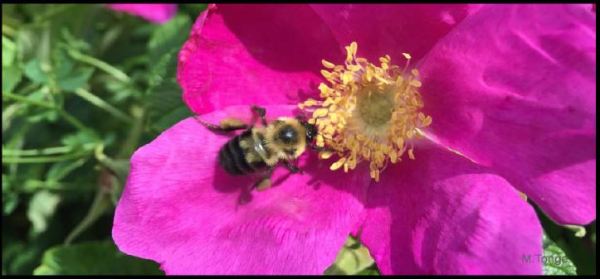
In 2015, the Ontario Ministry of Agriculture, Food and Rural Affairs (OMAFRA) commissioned a comprehensive review on bee health. The contractor, a University of Guelph group led by Dr. Nigel Raine, submitted its review in April 2016. Eleven months later it was made public via an obscure WordPress posting. The review is lengthy and contains a wealth of information on both honey and wild bees.
The following is for those interested in a quick overview of the review along with my personal comments.
The review provides a well-written description of the many pests and diseases which afflict managed bees. It states, “Pests affecting honey bees in Ontario are varroa mites, tracheal mites, wax moths, and the small hive beetle. Pathogens include numerous species of bacteria, fungi and viruses. Bumble bees, especially managed [Bombus] impatiens colonies, are affected by viruses, the trypanosome parasite Crithidia bombi, tracheal mites, the fungal infection Nosema bombi, and small hive beetle.”
The review joins others in emphasizing the overall importance of varroa mites and related control measures on honey bee well-being in Ontario. “Although beekeepers are actively managing their hives, mite levels are constantly rising in colonies,” says the review. Since 2016, varroa have been found in virtually all colonies. The review reports the difficulty of effective varroa control with genetic resistance developing in varroa mites to several key miticides, and the miticides themselves being quite detrimental to bee health.
The review also describes growing awareness of the importance of bee viruses to honey bee health, to a greater extent than I have seen in other public reports about bee health in Ontario. It notes, as have others, that honey bees weakened by varroa are more vulnerable to several bee viruses than was the case in pre-varroa times. The review notes the slowness of OMAFRA and the Ontario bee industry in introducing routine monitoring of Ontario bee colonies for the prevalence of viruses, in contrast to the regular monitoring occurring in the United States.
The review includes criticisms of beekeeper management in Ontario: “In Ontario, management practices are the second leading cause of overwintering mortality in honey bees after Varroa mite infestation (Guzman-Novoa et al. 2010). Specifically, having weak colonies, with insufficient numbers of workers entering the winter season, and having limited food reserves to carry bees through the winter contributes to their losses.”
Note also this quote: “the declining health of managed bees (honey bees, blue orchard bees, managed Bombus [bumble bee], and alfalfa leafcutter bees) is in part due to their management by humans.”
It is obvious that honey bee management, especially for over-winter survival, is especially challenging in a province like Ontario where hobbyists predominate. The average Ontario bee keeper has about 3-4 hives according to Statistics Canada, versus about 30 in Alberta, by comparison, where commercial production prevails.
The review also focuses on the 39% of Ontario colonies (2016 statistics) which are transported by beekeepers each spring to Quebec and Maritime Provinces for blueberry and cranberry pollination. The review notes that while honey bees are not good blueberry pollinators, this lack of effectiveness is countered by the use of large numbers of colonies per blueberry field – presumably creating stress for the bees themselves.
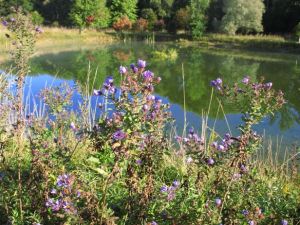
The review is inconsistent in its statements about changes in honey bee colony numbers. For example, “honey bee colony numbers have continued to decline” (page 26) versus “Over the past 10 years the number of colonies in Ontario has increased by 32.7%” (page 100). The review also includes data showing an upward trend in number if honey bee colonies for all of Canada.
The review includes a graph (“Figure 2,” pasted below) which implies that in Ontario, in contrast to some other provinces, the colony winter loss percentage may be trending upwards. However, if the graph had been updated to show the 37.8% and 17.9% losses reported for Ontario for 2014/15 and 2015/2016 the trend in Ontario would have appeared differently. Statistics provided by the Canadian Association of Professional Apiculturalists for 2013/2014, 2014/15 and 2015/16 are shown in the accompanying table.
(The review is inconsistent in the recency of its data, sometimes using statistics as current as 2016, and sometimes stopping two years earlier as in this case.)
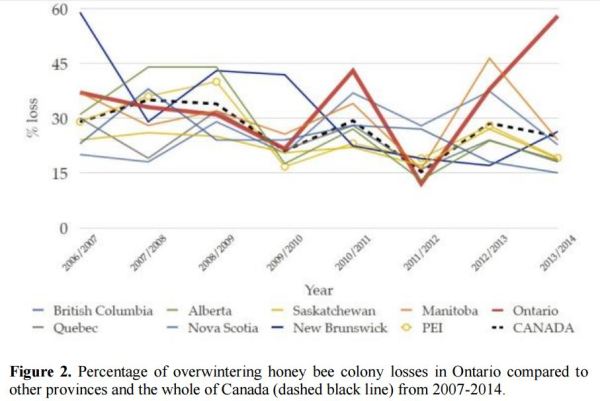
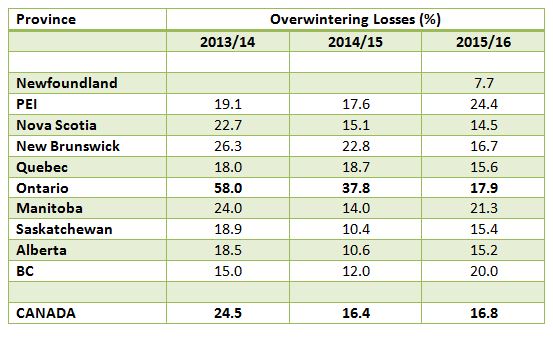 The review includes discussion of the 420 wild bee species found in Ontario, including 25 bumble bee species. Unlike some areas of the world (notably the UK and other parts of north-western Europe), there is very little information available on the population status of most wild species. We don’t know whether their numbers are in decline or not. (One bumble bee species, the Rusty Patched bumble bee, Bombus affinis, has likely become extinct in Ontario.)
The review includes discussion of the 420 wild bee species found in Ontario, including 25 bumble bee species. Unlike some areas of the world (notably the UK and other parts of north-western Europe), there is very little information available on the population status of most wild species. We don’t know whether their numbers are in decline or not. (One bumble bee species, the Rusty Patched bumble bee, Bombus affinis, has likely become extinct in Ontario.)
The review joins other reports in identifying honey bees as a serious threat to the well-being of wild bee species. Honey bees compete directly for nectar and pollen and are vectors for the spread of diseases and pathogens. (Varroa are not a pest of wild bees but the viruses associated with varroa are, and those viruses are spread during consecutive visits by different bee species to the same flowers.)
An argument is made that loss of habitat may be affecting wild bee populations in Ontario/Canada – and it would seem reasonable that this is true in some parts of the province – but there is a dearth of supporting data.
The review lists pesticides as a factor affecting bee health. However, the most serious culprits appear to be the pesticides used to control bee pathogens, especially mites. The review cites three studies from Ontario which have shown no effect of neonicotinoid (neonic) insecticides on honey bee health and notes that neonic effects are much more commonly found in laboratory studies than field research. The review gives attention to possible non-lethal effects of neonics on bees, a special area of research for Dr. Raine. However, the review pays little attention to a criticism that his conclusions are largely based on bee pesticide exposure levels significantly above what is generally found to occur in Ontario fields. (Researchers who evaluate pesticide effects on bees in artificial settings often refer to “field-realistic exposure,” when that is often not the case – especially for multi-day exposure.)
This review gives major attention to a Swedish field study where wild bee species (but not honey bees) showed sub-lethal effects when exposed to neonic-treated, spring-planted oilseed rape (known as canola in Canada). Not mentioned is the detail that the Swedish fields were planted with seed treated at 2.5 times the maximum neonic application rate permitted in Canada (personal communication, Canola Council of Canada).
Disappointingly, the review gives credence to a recent paper from the UK (Woodcock et al., 2016) where the authors claimed that a decline in the heath of several wild bees species was attributable to neonic usage, even though this conclusion was based solely on a correlation over years (neonic usage up, bees numbers down). Telling is this statement in a BBC feature on the Woodcock paper: “The authors acknowledge that their study finds an association and doesn’t prove a cause and effect link between the use of neonicotinoids and the decline of bee populations.” Contrast that with this unqualified statement in the current review, “[there were] significant negative impacts on species persistence associated with neonicotinoid use (Woodcock et al. 2016).” One suspects that a similar correlation between organic food sales and wild bee numbers in the IK would have been equally significant, statistically.
Ignored in the current review is a relevant 2011 Carleton University thesis study by Joanna James, in which she found essentially no difference in wild bee populations beside pesticide- (including neonic-) treated fields versus those receiving no pesticides.
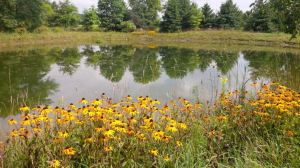
The authors say there is no supporting documentation, other than speculation, for a claim by others that declining wild bee populations are responsible for a decline in the well-being of 78 endangered plant species in Ontario. “Although provincial and federal governments identify the importance of pollinators, such as bees, as playing a key role in the survival for many of Ontario’s rare plants (e.g. http://www.ontario.ca/environment-and-energy/cucumber-tree-species-risk) results from our systematic literature review found no peer-reviewed or grey literature to support this.”
I am pleased the authors addressed an oft-repeated but rarely documented claim that one-third of food depends on bee-pollinated crops. The authors calculate that $0.9 billion (13%) of Ontario’s $6.7 billion in value of agricultural crop production involves bee-pollinated crops. In another calculation, they estimate that the value of pollinators to Ontario agriculture might be about $540 million per year, of which about two-thirds involves wild bees.
The review, unfortunately, is quite weak in considerations of agronomy and bee-agricultural interactions. Here are some examples:
- The review states without supporting references that alfalfa production is increasing in Canada because increasing demand for feed and because it is cheaper to plant this crop compared to wheat and barley (page 12). Cost of production data (available here) do not support this claim for seeding costs, and I doubt that the demand for alfalfa-based feed (essentially for dairy and some beef) is increasing in Canada.
- The authors do not appear to distinguish between alfalfa used for forage (does not require pollination) versus for seed (pollination needed). Indeed, in a table on page 110, the authors imply that the value of alfalfa seed production in Ontario averaged $109 million from 2009-2014. In reality, there is very little alfalfa seed production in Ontario and alfalfa grown for forage production is harvested in the vegetative state, often even before flowers appear.
- On pages 103 and 106, the authors erroneously dismiss carrots and potatoes as largely insignificant agricultural crops in Ontario.
- They refer in several places to parthenocarpic cultivars of canola, soybeans, peas, beans, ginseng, tomatoes and other crops, when it is highly doubtful that such exist. They appear to have confused the term, “parthenocarpic” (no fertilization required), for “self-pollinating.” On page 105 they refer to canola flowers being “self-incompatible and depend[ent] on generalist insect pollination.” That’s true for only Brassica rapa canola which represents less than 1% of Canadian production according to industry contacts.
- There are several undocumented suggestions in the review that fertilizer applications harm bees (see page 132), that manure is better than synthetic fertilizers for pollinator health and a page 124 statement that sowing grasses in rotation enhances soil fertility which makes no agronomic sense. (Grasses do improve soil structure.)
- They make a claim on page 131 that “Herbicide resistant canola fields have high levels of pesticide used,” apparently unaware of analyses such as that of Smyth et al (2014) showing substantial reductions in pesticide usage with glyphosate-tolerant canola in Western Canada.
The authors imply in other places that organic agriculture is better for crop pollination. They refer to a study by Morandin and Winston (2005), showing more complete pollination for flowers in organic canola versus herbicide-treated fields, a result they attributed to more weeds and more bees. But there are ample data to show it’s the reverse when it comes to canola yield: better weed control means better yields, implying that pollination is not the dominant yield limitation.
Many wild bee species are ground dwelling and one might expect that more frequent tillage with organic cropping (as compared to no tillage plus herbicide usage) would be detrimental to their well-being.
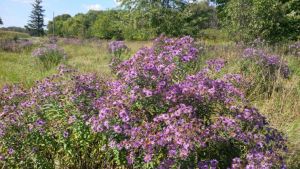
The authors also try to make the case on several occasions that a diversity of wild flowers and pollinators in surrounding areas enhances the yield of major crops, but their case is very weak. Several of the literature citations are only to other authors who have made the same conjecture. On Page 39 they state, “A meta-analysis by Ricketts et al. (2008), found that yield declined due to shortage of pollinators with increasing distances between the crop and natural or semi-natural habitats.” But the Ricketts paper actually says that this relationship has generally been found to be non-existent or not statistically significant.
This is not an attempt to argue on my part that wild flowers and wild bees aren’t important. Not at all. But why not base their importance on the value of natural diversity for its own inherent sake, and not on an attempted feeble linkage to agricultural productivity?
The authors emphasize the importance of wild flowers – even include photos in the report of beautiful wild flower stands – but overlook how difficult these stands can be to maintain. I speak from experience. About 20 years ago my wife and I naturalized a four-acre field on our farm, planting wild flowers in many areas. Twenty years later those wild flowers thrive (see the photos included in this blog). But that’s only because of many hours devoted each year to the removal of more competitive species. (The ones Mother Nature prefers are reed canarygrass, buckthorn shrubs/trees, and many noxious weeds like the invasive garlic mustard and several species of thistles.)
Wild flowers are great but not easy.
In summary this review represents a valuable contribution to the understanding of bee health in Ontario but would have benefitted if it had been reviewed, before release, by someone more familiar with field crop agriculture.
2 Comments